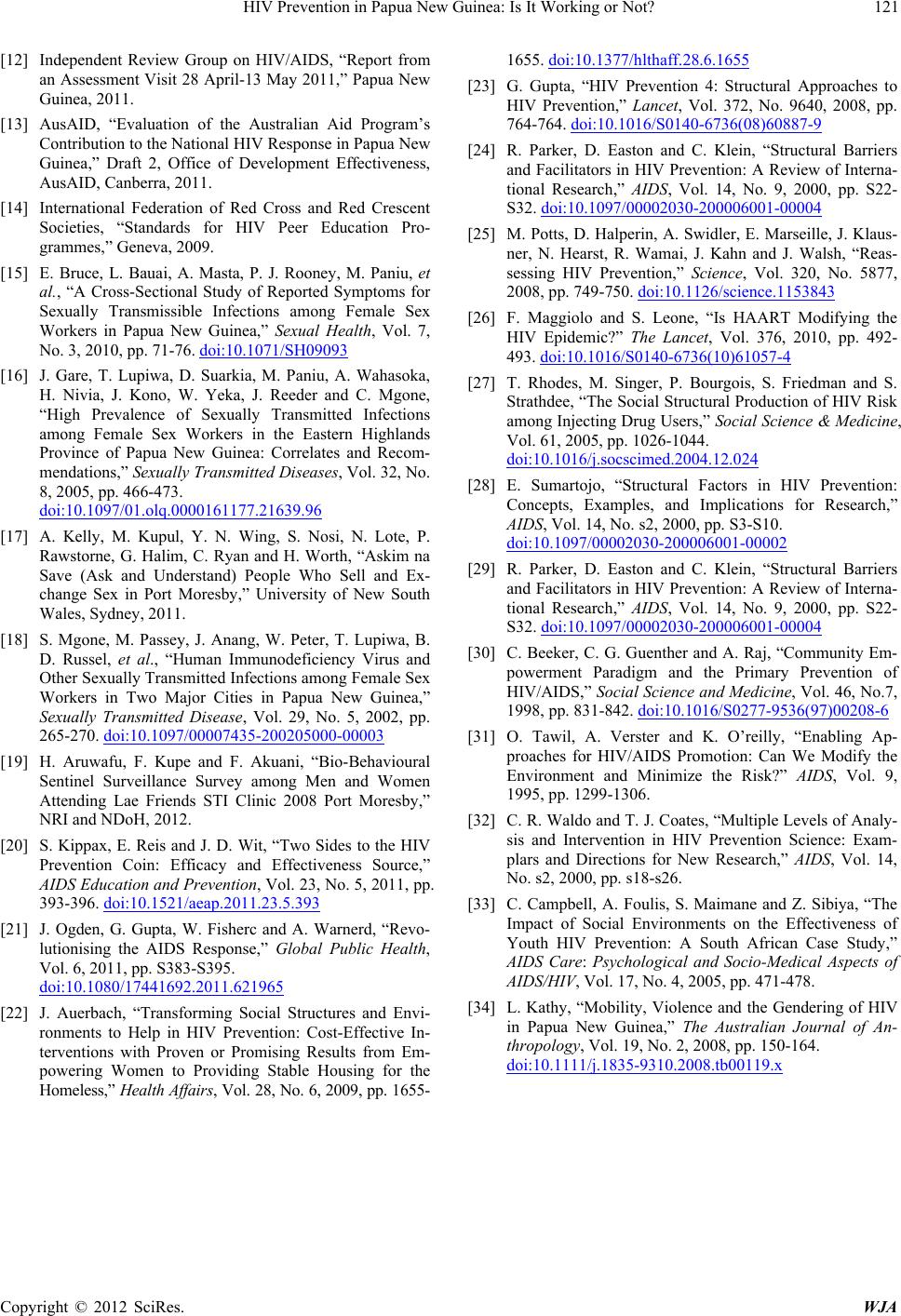
HIV Prevention in Papua New Guinea: Is It Working or Not? 121
[12] Independent Review Group on HIV/AIDS, “Report from
an Assessment Visit 28 April-13 May 2011,” Papua New
Guinea, 2011.
[13] AusAID, “Evaluation of the Australian Aid Program’s
Contribution to the National HIV Response in Papua New
Guinea,” Draft 2, Office of Development Effectiveness,
AusAID, Canberra, 2011.
[14] International Federation of Red Cross and Red Crescent
Societies, “Standards for HIV Peer Education Pro-
grammes,” Geneva, 2009.
[15] E. Bruce, L. Bauai, A. Masta, P. J. Rooney, M. Paniu, et
al., “A Cross-Sectional Study of Reported Symptoms for
Sexually Transmissible Infections among Female Sex
Workers in Papua New Guinea,” Sexual Health, Vol. 7,
No. 3, 2010, pp. 71-76. doi:10.1071/SH09093
[16] J. Gare, T. Lupiwa, D. Suarkia, M. Paniu, A. Wahasoka,
H. Nivia, J. Kono, W. Yeka, J. Reeder and C. Mgone,
“High Prevalence of Sexually Transmitted Infections
among Female Sex Workers in the Eastern Highlands
Province of Papua New Guinea: Correlates and Recom-
mendations,” Sexually Transmitted Diseases, Vol. 32, No.
8, 2005, pp. 466-473.
doi:10.1097/01.olq.0000161177.21639.96
[17] A. Kelly, M. Kupul, Y. N. Wing, S. Nosi, N. Lote, P.
Rawstorne, G. Halim, C. Ryan and H. Worth, “Askim na
Save (Ask and Understand) People Who Sell and Ex-
change Sex in Port Moresby,” University of New South
Wales, Sydney, 2011.
[18] S. Mgone, M. Passey, J. Anang, W. Peter, T. Lupiwa, B.
D. Russel, et al., “Human Immunodeficiency Virus and
Other Sexually Transmitted Infections among Female Sex
Workers in Two Major Cities in Papua New Guinea,”
Sexually Transmitted Disease, Vol. 29, No. 5, 2002, pp.
265-270. doi:10.1097/00007435-200205000-00003
[19] H. Aruwafu, F. Kupe and F. Akuani, “Bio-Behavioural
Sentinel Surveillance Survey among Men and Women
Attending Lae Friends STI Clinic 2008 Port Moresby,”
NRI and NDoH, 2012.
[20] S. Kippax, E. Reis and J. D. Wit, “Two Sides to the HIV
Prevention Coin: Efficacy and Effectiveness Source,”
AIDS Education and Prevention, Vol. 23, No. 5, 2011, pp.
393-396. doi:10.1521/aeap.2011.23.5.393
[21] J. Ogden, G. Gupta, W. Fisherc and A. Warnerd, “Revo-
lutionising the AIDS Response,” Global Public Health,
Vol. 6, 2011, pp. S383-S395.
doi:10.1080/17441692.2011.621965
[22] J. Auerbach, “Transforming Social Structures and Envi-
ronments to Help in HIV Prevention: Cost-Effective In-
terventions with Proven or Promising Results from Em-
powering Women to Providing Stable Housing for the
Homeless,” Health Affairs, Vol. 28, No. 6, 2009, pp. 1655-
1655. doi:10.1377/hlthaff.28.6.1655
[23] G. Gupta, “HIV Prevention 4: Structural Approaches to
HIV Prevention,” Lancet, Vol. 372, No. 9640, 2008, pp.
764-764. doi:10.1016/S0140-6736(08)60887-9
[24] R. Parker, D. Easton and C. Klein, “Structural Barriers
and Facilitators in HIV Prevention: A Review of Interna-
tional Research,” AIDS, Vol. 14, No. 9, 2000, pp. S22-
S32. doi:10.1097/00002030-200006001-00004
[25] M. Potts, D. Halperin, A. Swidler, E. Marseille, J. Klaus-
ner, N. Hearst, R. Wamai, J. Kahn and J. Walsh, “Reas-
sessing HIV Prevention,” Science, Vol. 320, No. 5877,
2008, pp. 749-750. doi:10.1126/science.1153843
[26] F. Maggiolo and S. Leone, “Is HAART Modifying the
HIV Epidemic?” The Lancet, Vol. 376, 2010, pp. 492-
493. doi:10.1016/S0140-6736(10)61057-4
[27] T. Rhodes, M. Singer, P. Bourgois, S. Friedman and S.
Strathdee, “The Social Structural Production of HIV Risk
among Injecting Drug Users,” Social Science & Medicine,
Vol. 61, 2005, pp. 1026-1044.
doi:10.1016/j.socscimed.2004.12.024
[28] E. Sumartojo, “Structural Factors in HIV Prevention:
Concepts, Examples, and Implications for Research,”
AIDS, Vol. 14, No. s2, 2000, pp. S3-S10.
doi:10.1097/00002030-200006001-00002
[29] R. Parker, D. Easton and C. Klein, “Structural Barriers
and Facilitators in HIV Prevention: A Review of Interna-
tional Research,” AIDS, Vol. 14, No. 9, 2000, pp. S22-
S32. doi:10.1097/00002030-200006001-00004
[30] C. Beeker, C. G. Guenther and A. Raj, “Community Em-
powerment Paradigm and the Primary Prevention of
HIV/AIDS,” Social Science and Medicine, Vol. 46, No.7,
1998, pp. 831-842. doi:10.1016/S0277-9536(97)00208-6
[31] O. Tawil, A. Verster and K. O’reilly, “Enabling Ap-
proaches for HIV/AIDS Promotion: Can We Modify the
Environment and Minimize the Risk?” AIDS, Vol. 9,
1995, pp. 1299-1306.
[32] C. R. Waldo and T. J. Coates, “Multiple Levels of Analy-
sis and Intervention in HIV Prevention Science: Exam-
plars and Directions for New Research,” AIDS, Vol. 14,
No. s2, 2000, pp. s18-s26.
[33] C. Campbell, A. Foulis, S. Maimane and Z. Sibiya, “The
Impact of Social Environments on the Effectiveness of
Youth HIV Prevention: A South African Case Study,”
AIDS Care: Psychological and Socio-Medical Aspects of
AIDS/HIV, Vol. 17, No. 4, 2005, pp. 471-478.
[34] L. Kathy, “Mobility, Violence and the Gendering of HIV
in Papua New Guinea,” The Australian Journal of An-
thropology, Vol. 19, No. 2, 2008, pp. 150-164.
doi:10.1111/j.1835-9310.2008.tb00119.x
Copyright © 2012 SciRes. WJA